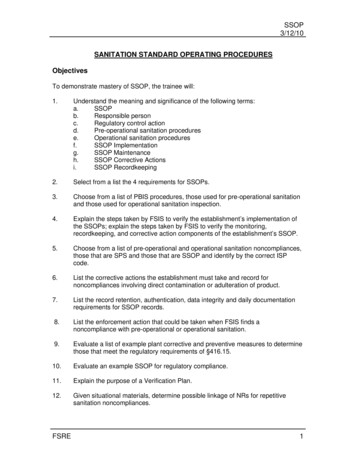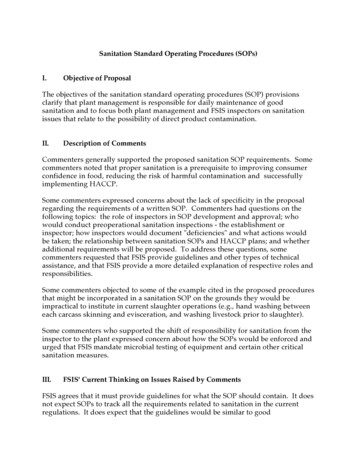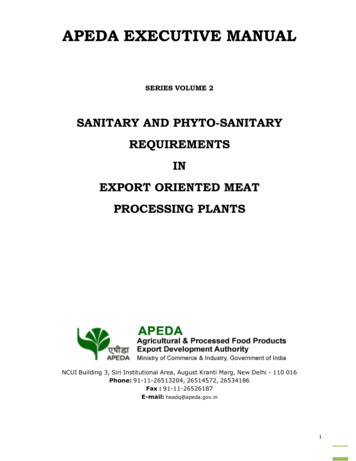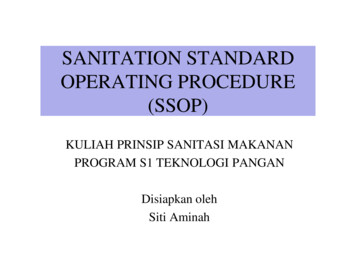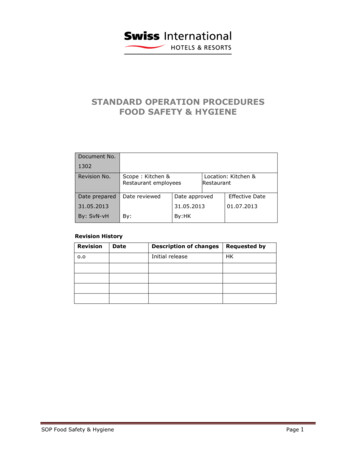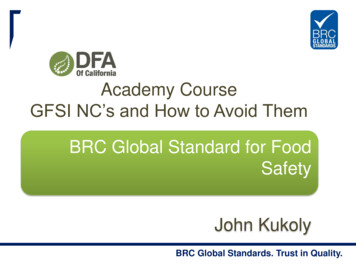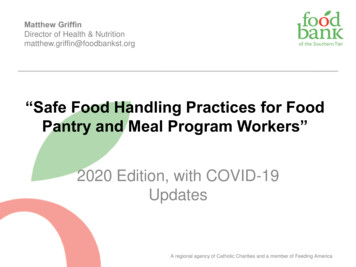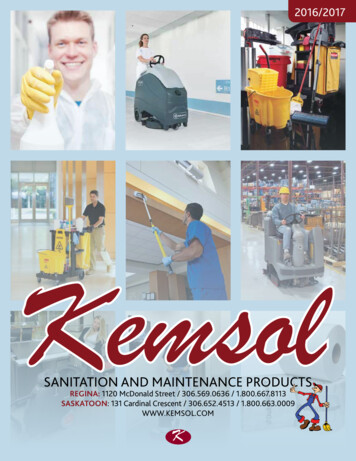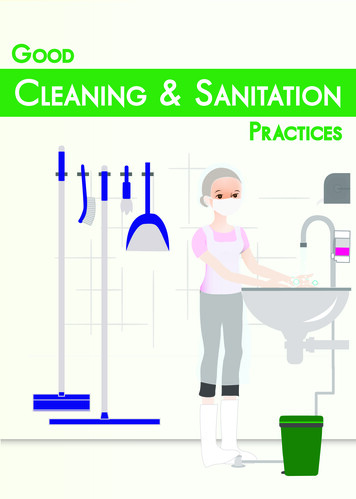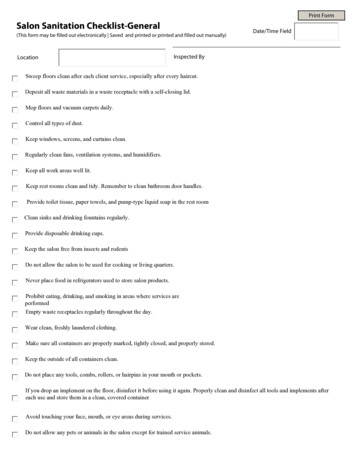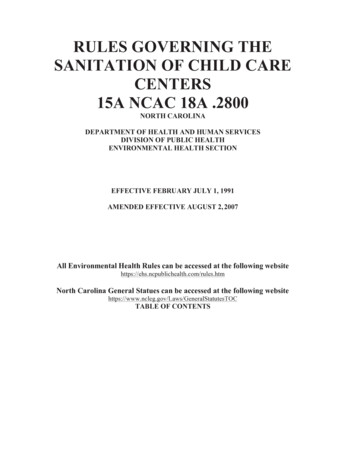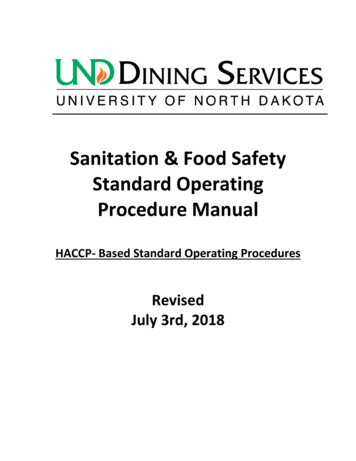
Transcription
Sanitation & Food SafetyStandard OperatingProcedure ManualHACCP- Based Standard Operating ProceduresRevisedJuly 3rd, 2018
HACCP-Based Standard Operating Procedures(Return to Table of Contents)Table of Contents1. Employee Sanitation StandardsA. Personal Hygiene .4B. Hands Washing & Hand Washing Sink. . .6C. Glove & Utensil Use When Handling Ready-to-Eat Foods .8D. Employee Uniforms .10E. Eating, Drinking, Taste Testing, & Breaks/Meals .13F. Employee Smoking/Tobacco Use . .15G. Employee Dressing Rooms 17H. Cuts, Burns or Lesions on Lower Arms or Hands .19I. Contact with Blood & Bodily Fluids .21J. Employee Illness . .232. Storage & ReceivingA. Standards for Receiving Food Central Foods Warehouse. 26B. Standards for Receiving Food All other Dining Venues. 29C. Handling Rejected Food 33D. Measuring Temperatures of Food Upon Receipt. .36E. Proper Training for Employees Who Store Food .38F. FIFO (First In, First Out) Stock Rotation. 40G. Standards for Dry Storage .42H. Standards for Cooler Storage .44I. Standards for Freezer Storage 46J. Standards for Bread Storage .48K. Corrective Action for Cooler & Freezer Temperatures .503. Food ProductionA. Controlling Time & Temperature During Production. 52B. Acceptable Thawing Procedures. .54C. Using & Calibrating Thermometers .56D. Date Marking & Ready to Eat (TCS) Food .58E. Washing Fruits & Vegetables 60F. Cooking (TCS) Foods . .62G. Cooling (TCS) Foods .65H. Holding Hot and Cold (TCS) Foods.68I. Reheating (TCS) Foods .70J. Standards for Deli Foods & Salad Bars .72JA. Deli Meats & Cheeses .74K. Food Production Sinks .78ii
HACCP-Based Standard Operating Procedures(Return to Table of Contents)4. Food SafetyA. Preventing Cross Contamination During Storage & Preparation .80B. Removing Food from the Cooler. 82C. Transporting Food to Remote Sites (Satellite Kitchens) .84D. Unattended Food. .87E. Serving Food .89F. Temperature Logs for the Serving Areas .91G. Acceptable Use of Leftovers .93H. Handling a Food Recall .955. Cleaning & SanitationA. Employee Training on Sanitation .97B. Storing & Using Poisonous or Toxic Chemicals .99C. Cleaning & Sanitizing Food Contact Surfaces 101D. Dish Room Standard Operating Procedures 105E. Floor Maintenance . .110F. Proper Storing of Equipment & Utensils .112G. Emptying of Garbage Receptacles. .116H. Prevention of Vermin or Insect Infestation .118I. Sanitation Inspections .1206. Incident ReportsA. Incident Reports .1227. Employee Alcohol & Drug PolicyA. Alcohol & Drug Prohibition . .1248. Sanitation & Food SafetyStandard Operating Procedure Annual TrainingA. Sanitation & Food SafetyB. Standard Operating Procedure Annual Training . 130iii
HACCP-Based Standard Operating Procedures(Return to Table of Contents)1A: Personal HygienePURPOSE: To prevent contamination of food by foodservice employees.SCOPE: This procedure applies to foodservice employees who handle, prepare, or serve food.KEY WORDS: Personal Hygiene, Cross-Contamination, ContaminationINSTRUCTIONS:1. Train foodservice employees on using the procedures in this SOP.2. Follow 2013 Grand Forks County Food Code Section General Personal Cleanliness 33-3304-293. Follow the Employee Illness SOP.4. Report to work in good health, clean, and dressed in clean attire.5. Change apron when it becomes soiled.6. Wash hands properly, frequently, and at the appropriate times.7. Fingernails are to be kept short and clean. No nail polish is allowed.No artificial nails are permitted in the food production area.8. Keep hair clean and wear approved hair/beard restraints (i.e. hairnets, or a UND issued hat),while working in the food preparation or serving areas.9. Bathe daily and wear acceptable amount of fragrance.10. The only jewelry that may be worn while working in the food preparation or service areas iswedding bands. No dangling jewelry or watches are allowed.11. No jewelry from visible piercings such as ears, lip, nose, eyebrow, tongue, etc. is to be wornduring shift.12. Report any illness to the manager on duty.4
HACCP-Based Standard Operating Procedures(Return to Table of Contents)1A: Personal Hygiene, continuedMONITORING:1. A direct supervisor will inspect employees when they report to work to be sure that eachemployee is following this SOP.2. The direct supervisor will monitor that all foodservice employees are adhering to the abovestated employee policy during all hours of operation.CORRECTIVE ACTION:1. Retrain any foodservice employee found not following the procedures in this SOP.2. Discard affected food.VERIFICATION AND RECORD KEEPING:The direct supervisor will verify that foodservice employees are following this SOP by visuallyobserving the employees during all hours of operation. The direct supervisor will complete theFood Safety Checklist daily. The Food Safety Checklist is to be kept on file for a minimum of 6months.DATE IMPLEMENTED: BY:DATE REVIEWED: BY:DATE REVISED: BY:5
HACCP-Based Standard Operating Procedures(Return to Table of Contents)1B: Hand Washing & Hand Washing SinksPURPOSE: To prevent foodborne illness by contaminated hands.SCOPE: This procedure applies to anyone who handles, prepare, and serve food.KEY WORDS: Hand washing, Cross-ContaminationINSTRUCTIONS:1. Train foodservice employees on using the procedures in this SOP.2. Follow 2013 Grand Forks County Food Code Section General Personal Cleanliness 33-3304-293. Post hand washing signs or posters in a language understood by all foodservice staff near allhand washing sinks, in food preparation areas, and restrooms.4. Use designated hand washing sinks for hand washing only.Do not use food preparation, utility, and dishwashing sinks for hand washing.5. Provide warm running water, soap, and a means to dry hands.Provide a waste container at each hand washing sink or near the door in restrooms.6. Keep hands washing sinks accessible anytime employees are present.7. Wash hands: Before starting work During food preparation When moving from one food preparation area to another Before putting on or changing gloves After using the restroom After sneezing, coughing, or using a handkerchief or tissue After touching hair, face, or body After touching clothing, shoes, or aprons. After smoking, eating, drinking, or chewing gum or tobacco After handling raw meats, poultry, or fish After any clean up activity such as sweeping, mopping, or wiping counters After handling chemicals which could affect food safety. After touching dirty dishes, equipment, or utensils After handling trash After handling money After any time the hands may become contaminated6
HACCP-Based Standard Operating Procedures(Return to Table of Contents)1B: Hand Washing & Hand Washing Sinks, continued8. Follow proper hand washing procedures as indicated below: Wet hands and forearms with warm, running water at least 100 ºF and apply soap. Scrub lathered hands and forearms, under fingernails, and between fingers for at least 1015 seconds. Rinse thoroughly under warm running water for 5-10 seconds. Dry hands and forearms thoroughly with single-use paper towels. Turn off water using paper towels. Use paper towel to open door when exiting the restroom.9. Follow FDA recommendations when using hand sanitizers.These recommendations are as follows: Use hand sanitizers only after hands have been properly washed and dried. Use only hand sanitizers that comply with the 2013 Grand Forks County Food Code. The hand sanitizers must be an alcohol-based hand sanitizer that contains at least 60%alcohol. Member’s Mark is the brand we are currently using.MONITORING:1. A direct supervisor will visually observe the hand washing practices of the foodservice staffduring all hours of operation.2. The direct supervisor will monitor that all foodservice employees are adhering to the abovestated employee policy during all hours of operation.CORRECTIVE ACTION:1. Retrain any foodservice employee found not following the procedures in this SOP.2. Ask employees that are observed not washing their hands at the appropriate times or usingthe proper procedure to wash their hands immediately.VERIFICATION AND RECORD KEEPING:The direct supervisor will complete the Food Safety Checklist daily to indicate that monitoring isbeing conducted as specified. The Food Safety Checklist is to be kept on file for a minimum of 6months.DATE IMPLEMENTED: BY:DATE REVIEWED: BY:DATE REVISED: BY:7
HACCP-Based Standard Operating Procedures(Return to Table of Contents)1C: Glove & Utensils Use When Handling Ready-to-Eat FoodsPURPOSE: To prevent foodborne illness due to hand-to-food cross-contamination. All foodwill be served in a manner to ensure food safetySCOPE: This procedure applies to foodservice employees who prepare, handle, or serve food.KEY WORDS: Ready-to-Eat Food, Cross-ContaminationINSTRUCTIONS:1. Train foodservice employees on using the procedures in this SOP.2. Follow 2013 Grand Forks County Food Code Section General Equipment and UtensilsMaterials and Use 33-33-04-323. Use proper hand washing procedures to wash hands and exposed arms prior to preparing orhandling food or at any time when the hands may have become contaminated.4. Do not use bare hands to handle ready-to-eat foods at any time unless washing fruits andvegetables.5. Use suitable utensils when working with ready-to-eat food. Utensils should be cleaned andsanitized at least once every two hours during continuous use.6. Suitable utensils may include: Single-use gloves Deli tissue Foil wrap Tongs, spoodles, spoons, and spatulas7. Serving utensils can be stored in the food with the handle extended above the rim of thecontainer or placed on a clean, sanitized food-contact surface.8. Glassware and dishes should be held by handles or bottom of the dishes and not the foodcontact areas. Flatware and utensils should be held at the handle.9. Glassware and dishes should not be stacked when serving.Glasses should be carried on a rack or on a tray.10. Wash hands and change gloves: Gloves must never be used in place of hand washing. 8Before beginning food preparationBefore beginning a new taskAt least every four hours during continual use, and more often when necessary.After touching equipment such as refrigerator doors or utensils that have not beencleaned and sanitizedAfter finishing handling raw meat and before handling cooked or ready-to-eat foods
HACCP-Based Standard Operating Procedures(Return to Table of Contents)1C: Glove & Utensils Use When Handling Ready-to-Eat Foods,continuedINSTRUCTIONS: continued After contacting chemical11. Cover cuts and sores on hands, including fingernails, with clean bandages. If hands arebandaged, clean gloves or finger cots (blue protective coverings) should be worn at all timesto protect the bandage and to prevent it from falling into food. Change gloves or finger cotsas appropriate.MONITORING:1. A direct supervisor will visually observe that gloves or suitable utensils are used and changedat the appropriate times during all hours of operation.2. The direct supervisor will monitor that all foodservice employees are adhering to the abovestated employee policy during all hours of operation.CORRECTIVE ACTION:1. Retrain any foodservice employee found not following the procedures in this SOP.2. Discard ready-to-eat food touched with bare hands.VERIFICATION AND RECORD KEEPING:The direct supervisor will verify that foodservice workers are using suitable utensils by visuallymonitoring foodservice employees during all hours of operation. The direct supervisor willcomplete the Food Safety Checklist daily. The direct supervisor responsible for monitoring willrecord any discarded food on the Damaged and Discarded Product Log. The Food SafetyChecklist and Damaged and Discarded Food Log are kept on file for a minimum of 6 months.DATE IMPLEMENTED: BY:DATE REVIEWED: BY:DATE REVISED: BY:9
HACCP-Based Standard Operating Procedures(Return to Table of Contents)1D: Employee Uniform StandardsPURPOSE: To prevent foodborne illness due to hand-to-food cross-contamination.SCOPE: This procedure applies to foodservice employees who prepare, handle, or serve food.KEY WORDS: Ready-to-Eat Food, Cross-ContaminationINSTRUCTIONS:1. Train foodservice employees on using the procedures in this SOP.2. Follow 2013 Grand Forks County Food Code Section General Personal Cleanliness 33-3304-293. Employees will change into the uniforms provided for them by UND after clocking in forwork.4. Employees must clock out at the end of their shift before changing out of their uniform.5. Hair restraints such as hairnets, hair coverings (UND approved hats, skull caps, chef hats,etc.) which covers 100% of hair, must be worn at all times when working in a foodpreparation or food serving area.6. Employees will change out of uniforms and into street clothes when leaving their
HACCP-Based Standard Operating Procedures (Return to Table of Contents) 7 1B: Hand Washing & Hand Washing Sinks, continued 8. Follow proper hand washing procedures as indicated below: Wet hands and forearms with warm, running water at least 100 ºF and apply soap.
